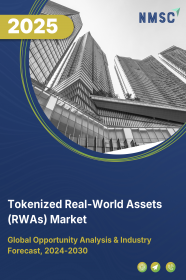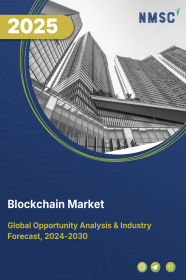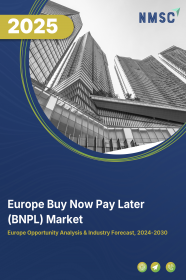
Tokenized Real-World Assets (RWAs) Market by Asset Type (Real Estate, Private Credit, Debt Instruments, Commodities, Stocks, & Others), By Technologies (Public Blockchains & Private Networks), By Components (Issuance Platforms, Custodial Services, & Secondary Trading Venues), By Application, (Investment, Trading, Collateral), By End-user (Banks, Real Estate Firms, Fund Managers, & Specialized Blockchain Service Providers) – Global Opportunity Analysis and Industry Forecast 2025-2030
US Tariff Impact on Tokenized Real-World Assets (RWAs) Market
Trump Tariffs Are Reshaping Global Business
Industry Overview
The global Tokenized Real-World Assets (RWAs) Market size was valued at USD 297.71 billion in 2024 and is expected to reach USD 612.71 billion by the end of 2025. The industry is predicted to reach USD 9.43 trillion by 2030 with a CAGR of 72.8% from 2025-2030.
The tokenized RWAs market has rapidly evolved in the last few years, fuelled by private credit, real estate, and commodities tokenization. Continued technological innovation in blockchain platforms and smart contracts is a primary driver, reducing transaction frictions and enabling fractional ownership. Regulatory advancements in countries such as Switzerland and Singapore are providing clarity and building institutional trust.
However, fragmented global regulatory frameworks and concerns around custody and fraud remain significant challenges. Opportunities lie in sustainable asset tokenization, particularly carbon credits, and in the expansion of secondary markets, which can enhance liquidity and price discovery.
Blockchain and Smart Contract Innovation Driving the Tokenized RWAs Market Growth
Blockchain and smart contract maturity have significantly reduced settlement times from days to seconds and can cut operational costs by up to 30 percent. For example, a substantial volume of transactions, exceeding USD 1.5 trillion since its inception, with a daily average of over USD 2 billion, demonstrating the transformative power of programmable assets. This rapid execution capability not only enhances market efficiency but also attracts institutional participants seeking scalable solutions. Executives should therefore invest in integrating tokenization pilots with existing legacy systems to capitalize on these operational efficiencies.
Regulatory Clarity Enhancing the Tokenized Real-World Assets Market Expansion
Institutions like Singapore’s Monetary Authority (MAS) and Switzerland’s FINMA have enacted frameworks that recognize tokenized securities, reducing legal ambiguity and bolstering investor confidence. Industry participants can use these regulatory safe harbours as testing grounds before scaling globally, thus accelerating time-to-market for new tokenized products.
Fractional Ownership Stimulating Growth Potential for the Tokenized Real-World Assets (RWAs) Market
Tokenized real estate alone is expected to hold a significant share in terms of asset value by the end of this decade, with fractional shares enabling smaller investors to participate in high-value assets previously accessible only to large institutions.
For example, the tokenization platform ADDX enabled retail investors to own fractions of Singapore office towers with ticket sizes as low as USD 5,000. This democratization broadens the investor base and supports diversified portfolios. Asset managers should therefore develop tailored fractional ownership models for their end clients to tap into this expanding investor segment.
Regulatory Fragmentation and Interoperability Issues Impeding the Tokenized RWAs Industry Growth Potential
Despite pockets of regulatory progress, there is no universal standard for tokenized assets, leading to compliance complexities when operating across borders. Firms face divergent requirements on custody, anti-money-laundering, and securities laws, increasing legal costs, and delaying product launches.
For instance, a European tokenized bond offering had to navigate ten separate regulatory regimes, adding six months to its time-to-market. Industry consortia should therefore collaborate with standard-setting bodies such as the ERC-3643 Association to advocate for interoperable frameworks that streamline cross-jurisdictional token transfers.
Also, a lack of blockchain interoperability restricts tokenized RWA scalability, with private blockchains often incompatible. A tokenized real estate fund on Ethereum struggles to integrate with Polygon-based DeFi protocols, limiting liquidity. The analysis indicates that seamless cross-chain communication is critical for market expansion. Companies should invest in interoperability solutions like the Inter-Blockchain Communication (IBC) protocol to enhance liquidity and foster ecosystem growth.
Security and Custody Risks Challenging the Tokenized RWAs Market Expansion
The rapid expansion of tokenized commodities has outpaced the development of secure custody solutions, raising concerns over hacks and fraud. In 2024, a mid-sized DeFi platform lost $25 million in a smart contract exploit, highlighting vulnerabilities inherent in nascent infrastructure.
Investors and custodians must implement multi-party computation (MPC) and hardware security modules (HSMs) to fortify key management. Moreover, service providers should pursue SOC 2 and ISO 27001 certifications to reassure stakeholders regarding their security posture.
Sustainable Asset Tokenization & Tokenized Treasuries Creating Market Growth Opportunities
The tokenization of environmental assets, such as carbon credits and renewable energy certificates, represents a significant market. Significant growth has been witnessed in the annual issuances of tokenized carbon credits in 2024, driven by corporate net-zero mandates.
A real-world example is Verra’s partnership with IBM to issue tokenized Verified Carbon Units, enabling real-time tracking and trading. Asset managers and sustainability officers should explore pilot programs in environmental, social, and governance (ESG) tokenization to capture first-mover advantages and support corporate decarbonization strategies.
On the other hand, Tokenized U.S. treasuries represent significant growth opportunities, with a 92% market spike post-BlackRock’s BUIDL launch. Ondo Finance’s OUSG fund, offering tokenized treasury exposure, attracted USD 88 million in assets.
Tokenized treasuries appeal to risk-averse investors, bridging TradFi and DeFi. Firms should develop treasury-backed tokenized products and leverage regulatory sandboxes to accelerate adoption, capitalizing on this high-yield, low-risk segment.
Market Segmentation and Scope of Study
The tokenized RWA market report is segmented on the basis of asset types, technologies, components, applications, end-user verticals, and regions. On the basis of asset types, the market is divided into real estate, private credit, debt instruments, commodities, stocks, intellectual property, and others. On the basis of technologies, the market is categorized into public blockchains (Ethereum) and private networks (Hyperledger Fabric). By components, the market is segmented into issuance platforms, custodial services, and secondary trading venues. On the basis of application, the market is divided into investment, trading, and collateral. By end user, the market is segmented into banks, real estate firms, fund managers, and specialized blockchain service providers. Regional breakdown and analysis of each of the aforesaid segments includes regions comprising North America, Europe, Asia-Pacific, and RoW.
Geographical Analysis
In North America, the U.S. leads adoption in the tokenized RWAs market share, driven by early blockchain networks and progressive state-level regulations. Canada has followed with sandbox initiatives fostering innovation in tokenized securities.
Europe exhibits strong activity in regulated token offerings across Switzerland, Liechtenstein, and Malta. In the Asia-Pacific, Singapore’s MAS and Hong Kong’s SFC have authorized multiple token service providers. China’s digital yuan pilot also includes tokenized bond trials.
Key Player Strategies and Developments
The tokenized RWAs industry is led by BlackRock, JPMorgan, Franklin Templeton, WisdomTree, Ondo Finance, Maple Finance, Securitize, Polytrade, Swarm Markets, Aptos Labs, Centrifuge, Goldfinch, Mantra Chain, IX Swap, and Taurus. A key trend is institutional integration, with firms launching tokenized funds and platforms. BlackRock’s BUIDL fund and JPMorgan’s Tokenized Collateral Network (TCN) exemplify TradFi-DeFi convergence.
Major financial institutions and fintechs are converging on RWA tokenization, forming strategic partnerships and launching dedicated platforms. BlackRock has filed for blockchain-based digital share funds, while JPMorgan’s Kinexys platform is processing over $2 billion in daily transactions. Goldman Sachs announced a tokenized fund pilot targeting private credit, and State Street is exploring tokenized ETF solutions alongside Invesco. Circle integrated native USD Coin (USDC) and the Cross-Chain Transfer Protocol (CCTP) V2 into World Chain, and Coinbase expanded custody services to include tokenized securities.
On the providers’ side, Securitize achieved SEC registration as a transfer agent. Venture-backed platforms like Polymath and others secured Series B funding to enhance compliance features. Across these developments, the pattern reveals a two-pronged approach: incumbents focusing on institutional-grade infrastructure and fintechs innovating on compliance and fractional ownership. For industry executives, aligning with ecosystem players, either through partnerships or investments, is critical to secure market positioning and navigate evolving regulatory landscapes.
Key Benefits
-
The report provides quantitative analysis and estimations of the industry from 2025 to 2030, which assists in identifying the prevailing tokenized real-world assets (RWAs) market opportunities.
-
The study comprises a deep-dive analysis of the current and future tokenized RWAs market trends to depict prevalent investment pockets in the sector.
-
Information related to key drivers, restraints, and opportunities and their impact on the tokenized real-world assets (RWAs) market is provided in the report.
-
Competitive analysis of the key players, along with their market share, is provided in the report.
-
SWOT analysis and Porter's Five Forces model are elaborated in the study.
-
Value chain analysis in the tokenized real-world assets market study provides a clear picture of the roles of stakeholders.
Tokenized Real-World Assets (RWAs) Market Key Segments
By Asset Types
-
Real Estate
-
Private Credit
-
Debt Instruments
-
U.S. Treasury Debt
-
Non-U.S. Government Debt
-
Corporate Bonds
-
-
Commodities
-
Stocks
-
Intellectual Property
-
Others
By Technology
-
Public Blockchains (Ethereum)
-
Private Networks (Hyperledger Fabric)
By Component
-
Issuance Platforms
-
Custodial Services
-
Secondary Trading Venues
By Application
-
Investment
-
Trading
-
Collateral
By End User
-
Banks
-
Real Estate Firms
-
Fund Managers
-
Specialized Blockchain Service Providers
By Region
-
North America
-
The U.S.
-
Canada
-
Mexico
-
-
Europe
-
The UK
-
Germany
-
France
-
Italy
-
Spain
-
Denmark
-
Netherlands
-
Finland
-
Sweden
-
Norway
-
Russia
-
Rest of Europe
-
-
Asia-Pacific
-
China
-
Japan
-
India
-
South Korea
-
Australia
-
Indonesia
-
Singapore
-
Taiwan
-
Thailand
-
Rest of Asia-Pacific
-
-
RoW
-
Latin America
-
Middle East
-
Africa
-
Key Players
-
BlackRock
-
JPMorgan
-
Franklin Templeton
-
WisdomTree
-
Ondo Finance
-
Maple Finance
-
Securitize
-
Polytrade
-
Swarm Markets
-
Aptos Labs
-
Centrifuge
-
Goldfinch
-
Mantra Chain
-
IX Swap
-
Taurus
REPORT SCOPE AND SEGMENTATION:
|
Parameters |
Details |
|
Market Size in 2024 |
USD 297.71 Billion |
|
Revenue Forecast in 2030 |
USD 9.43 Trillion |
|
Growth Rate |
CAGR of 72.8% from 2025 to 2030 |
|
Analysis Period |
2024–2030 |
|
Base Year Considered |
2024 |
|
Forecast Period |
2025–2030 |
|
Market Size Estimation |
Billion (USD) |
|
Growth Factors |
|
|
Countries Covered |
28 |
|
Companies Profiled |
15 |
|
Market Share |
Available for 10 companies |
|
Customization Scope |
Free customization (equivalent to up to 80 working hours of analysts) after purchase. Addition or alteration to country, regional, and segment scope. |
|
Pricing and Purchase Options |
Avail customized purchase options to meet your exact research needs. |

















 Speak to Our Analyst
Speak to Our Analyst


















